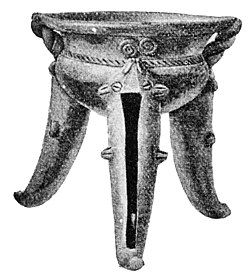ing pellets. Notwithstanding the beauty and symmetry of their work, the Chiriquians seem to have lacked one faculty that the people farther north, in Honduras and the Yucatan peninsula,  Fig. 6. had fully developed; for they failed to portray, even poorly, the human face, while the latter were clever portraitists.
Fig. 6. had fully developed; for they failed to portray, even poorly, the human face, while the latter were clever portraitists.
In Honduras a wealth of pottery may be dug from the soil; but this must be done with care, otherwise the frail things will inevitably be broken, owing to their moist condition. When exposed to air and sunlight they become hardened and may be handled with less risk.
At Mugeres or Woman's Island (latitude 31° 18' north and longitude 86° 42' west, Greenwich meridian)—so called by the Spaniards because they found many statues of women there—an ancient shrine stands on a rocky promontory at the south end of the island. There the waves perpetually dash themselves as if in blind fury. Atom by atom the rocks must yield to the force of perpetual motion; then this old shrine of strong masonry will fall into the maw of Neptune. Long ago thousands of pilgrims used to bring to the spot votive offerings of all kinds. Fragments of pottery are scattered over the ground in front of the building. Delving in the sand, we brought to light a fine incense-burner. Unfortunately, a man, too anxious to help, thrust a spade in the sand and broke the object before we had time to say "Hold!"
Afterward, in one of the fragments, we kindled charcoal to varnish photographs which we had taken. From the heated pottery an exquisite odor was wafted on the air. Thus, once again, and probably for the last time, was the shrine perfumed with the sweet incense which had permeated the porous clay, and truly it was delicious enough to delight not only the most fastidious devotees but the most exacting divinities. The face which had ornamented the burner escaped injury, as did the feet from the lower part of the brazier. Able potters of these modern times have pronounced the face a very fine piece of modeling. It is now in the museum of the Antiquarian Society of Worcester, Mass. The woman represented did not belong to any of the races that followed the customs of deforming their skulls; but she had her front teeth filed in points, a fashion which was in vogue among some Americans as it is among the Fans of equatorial
